Here Comes the Sea: The Struggle to Keep the Ocean out of California’s Coastal Aquifers
Farm districts preserve fresh groundwater with recycled wastewater
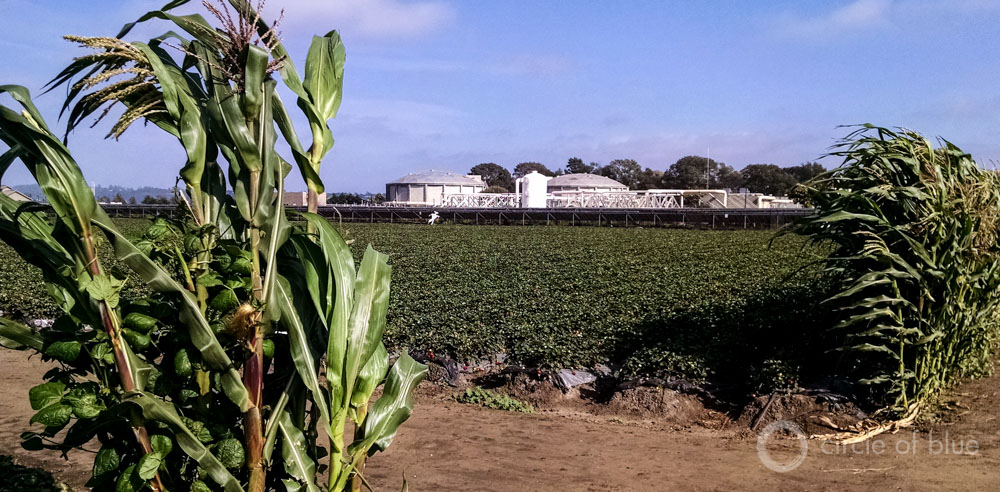
The Watsonville, California, recycled water facility, completed in 2009, purifies wastewater from the city of Watsonville for use by farmers in the Pajaro Valley. Using recycled water instead of groundwater prevents the Pacific Ocean from spoiling coastal aquifers with salt. Photo © Brett Walton / Circle of Blue
WATSONVILLE, California — Driving on the world-famous Route 1, just south of town, a traveler looking west across fields of strawberries can see the great silvery expanse of the Pacific Ocean.
The land is heavy with a harvest that will soon be trucked to grocery stores and fruit stands throughout the United States. The Pacific, in the late afternoon sun, dazzles like camera flashes. But the ocean also is stealthy. It creeps inland in less obvious, more destructive ways. Beneath the berry patch, a rising tide of salty water threatens one of the most lucrative and productive farm regions in the country. Coastal wells are slowly being poisoned with rising concentrations of chloride.
“Saltwater intrusion is the biggest untold water story in the world today. It’s a silent problem. It’s easy to ignore politically but it can spoil the water source for future generations.”
–Ron Duncan, interim general manager
Soquel Creek Water District
Saltwater intrusion, the technical name for the problem, occurs when too much groundwater is pumped from coastal aquifers, thereby upsetting the subterranean balance between inland freshwater and the relentless ocean. Water moves through the ground as it does in rivers: from high elevation to low. At the margin of a coastal aquifer, fresh water and salt water mix. When the rate of groundwater pumping increases, the equilibrium shifts. As aquifer levels drop, the saltier water trickles in, filling the gaps in the sandy soil where fresh water used to be.
Saltwater intrusion challenges nearly every town and farm district in California that borders the Pacific. Many have been fighting back the ocean for generations. Bulletin 52, the first state report to document the salt problem in the Salinas Valley, a farming center just south of Watsonville, was published in 1946. Orange County, a wealthy county near Los Angeles, built a facility in 1976 that injects treated wastewater into the aquifer, to form a freshwater barrier against the ocean.
Kept in abeyance along the Central Coast by prudent investments to establish freshwater barriers made in the last two decades, the salt surge is again pushing forward because of the state’s four-year drought emergency. In response, coastal communities are redoubling efforts to protect their water supply from the ocean, by recycling wastewater, expanding existing recycling systems, and looking for alternatives to the groundwater supplies that gave rise to a farm industry worth billions.
“Saltwater intrusion is the biggest untold water story in the world today,” Ron Duncan, interim general manager of Soquel Creek Water District, told Circle of Blue. “It’s a silent problem. It’s easy to ignore politically but it can spoil the water source for future generations.”
California’s coastal communities have not ignored the problem. Soquel Creek, a small district east of Santa Cruz, declared a groundwater emergency in June 2014, in large part because of saltwater intrusion. The district is the latest in the region to confront a hazard that developed over decades. The steps that its neighbors on the Central Coast — Pajaro Valley and Salinas Valley — have taken to fend off the ocean are a model for many coastal regions around the world that are threatened by salt.
A Threat Common to Coastal Communities
Saltwater intrusion is not confined to California. It is a national and international threat, a symptom of growing populations, rising groundwater use, and increased demand for water for food production, industrial development, and urban expansion. In the United States, towns from Cape Cod to Long Island and the Florida Gulf Coast to the Mississippi River Delta are fighting the salt surge. A water district on Hilton Head Island, a South Carolina resort community, shut down six wells in the last decade because of salt.
Globally, more than 1 billion people rely on coastal aquifers for drinking water and irrigation. In delta megacities and in agrarian capitals the ocean is pushing inland, a result of demands on groundwater that far exceed a sustainable rate of consumption. In Jakarta, Indonesia, a city of 10 million people, wells at least 11 kilometers (7 miles) inland have been contaminated with salt. In Chennai, India, salt water is detected nearly 15 kilometers (9 miles) from the coast.
But few places in the world have met the saltwater problem with the vigor and tenacity of the water districts in California.
A Groundwater Tragedy on the Central Coast
The northern section of the Central Coast — the counties of Monterey, San Benito, and Santa Cruz — is an island in California’s interconnected water network. The region is not linked to the State Water Project, the system of canals and reservoirs that moves water hundreds of kilometers from the Sierra Nevada foothills to Los Angeles and San Diego. There is no imported water to bail out unsustainable local practices. The region is hydrologically isolated.
“We are dealing with our own problem,” Matt Orbach, of Soquel Creek Water District, told Circle of Blue. “We live and die by our own decisions.”
Those decisions center on groundwater, which supplies more than 80 percent of the region’s water. No part of the state gets a larger fraction of its water supply from aquifers than the Central Coast.
Groundwater, combined with a climate that allows for year-round cultivation, turned the region into a horn of plenty. The Pajaro Valley produced nearly $US 1 billion worth of artichokes, strawberries, lettuce, cauliflower, and other crops in 2013, on just 28,000 irrigated acres. Monterey County, which extends into the Pajaro Valley, totaled $US 4.5 billion in farm sales in 2014.
Groundwater built the region into an agricultural powerhouse. But, in a tragic twist, the farmers drank too deeply. They used more groundwater than the basin could sustain.
Earlier this year, the California Department of Water Resources designated groundwater basins in Soquel, the Pajaro Valley, and the Salinas Valley as “critical” because of saltwater intrusion. In Monterey County, the salt water boundary, at its farthest reach, is more than 10 kilometers (6 miles) inland. Each of the basins must eventually put tighter controls on groundwater consumption, thanks to a landmark state law that was signed last year.
Many managers in the region believe that the drought will worsen the saltwater intrusion problem, which had largely been halted before 2013, because there is little rainfall to replenish the aquifers and in many areas groundwater pumping has increased. Groundwater levels are 1 meter (3 feet) lower in the uppermost aquifer of the Salinas Valley, compared to 2014, according to the Monterey County Water Resources Agency. Most of the Pajaro Valley groundwater basin is now below sea-level, according to Pajaro Valley Water Management Agency calculations. That is an open door for salt water.
A Region Responds
Water managers are not sure how far the salt front has advanced. Monitoring reports for 2015 will be published next winter and spring. Managers have heard stories of wells going sour and farmers drilling deeper for water, so they suspect that the salt boundary will shift. Seawater, however, moves slowly and the full effect of the current drought will not be known for several years, according to Brian Lockwood, hydrologist for Pajaro Valley Water Management Agency.
Managers expect that the drought will not be as great a problem as it could have been because of actions and collaborations that the water districts took years ago.
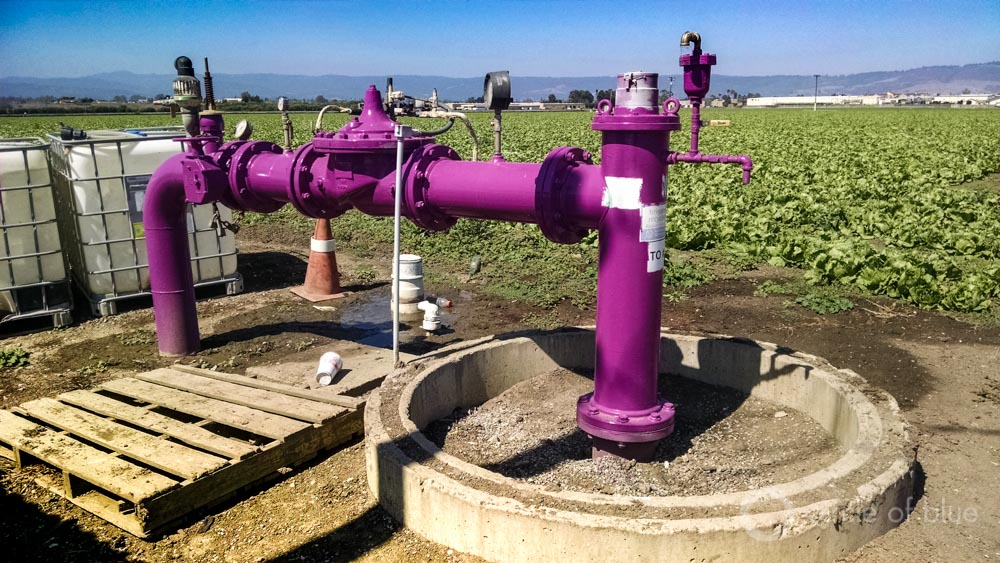
A 32-kilometer (20-mile) purple pipe system delivers recycled water from Watsonville, California, to farmers in the Pajaro Valley, some of the most lucrative farmland in the state. Photo © Brett Walton / Circle of Blue
Pajaro Valley Water Management Agency, for instance, worked with the city of Watsonville to provide farmers with an alternative to groundwater. In 2009, the two entities opened a facility that purifies city water for use in the fields. A 32-kilometer (20-mile) network of purple pipes carries the recycled water to growers along the coast.
“When growers get salt in their wells, they come begging us to be on the system,” Mary Bannister, general manager of Pajaro Valley Water Management Agency, told Circle of Blue.
Pajaro Valley’s water recycling scheme is similar in concept to the Castroville Seawater Intrusion Project, the first facility in the state to use recycled water on vegetables. Opened in 1998, the Castroville facility provides irrigation water to 4,850 hectares (12,000 acres) in the Salinas Valley.
“People pay into the system because they recognize that stopping seawater intrusion is the most important thing for us, or we lose the valley,” Gary Peterson, director of public works for the city of Salinas, told Circle of Blue. Lose the valley? “That means we can’t grow anything here,” Peterson said.
Seawater intrusion in the Salinas Valley had stopped in 2013 because of investments such as the Castroville facility.
Pajaro’s recycled water system is so successful that it is expanding. The agency received $US 2.1 million in funding from a state drought fund to help extend the purple pipe system to areas that are not currently connected.
In Monterey County, a new water recycling system is completing a design review. Pure Water Monterey is a partnership between the Monterey Regional Water Pollution Control Agency and the Monterey Peninsula Water Management District. By 2017, the facility will produce 3,500 acre-feet of recycled water from industrial wastewater, farm drainage, and stormwater, for injection into the aquifer and for farm irrigation. The WateReuse Association, a trade group, named Pure Water Monterey its agricultural project of the year for 2015.
Soquel Creek, for its part, is moving its water production wells away from the coast, at a cost of $US 1 million to $US 3 million per well. The district recently finished relocating its second well. The district also began a year-long study in July to assess the feasibility of injecting recycled water into the aquifer, to reinforce the freshwater barrier against the Pacific.
As the seas continue to rise, demands for water increase, and rainfall becomes more erratic, more such investments and changes in practices will be necessary if the Central Coast is to remain America’s land of plenty.
Brett writes about agriculture, energy, infrastructure, and the politics and economics of water in the United States. He also writes the Federal Water Tap, Circle of Blue’s weekly digest of U.S. government water news. He is the winner of two Society of Environmental Journalists reporting awards, one of the top honors in American environmental journalism: first place for explanatory reporting for a series on septic system pollution in the United States(2016) and third place for beat reporting in a small market (2014). He received the Sierra Club’s Distinguished Service Award in 2018. Brett lives in Seattle, where he hikes the mountains and bakes pies. Contact Brett Walton



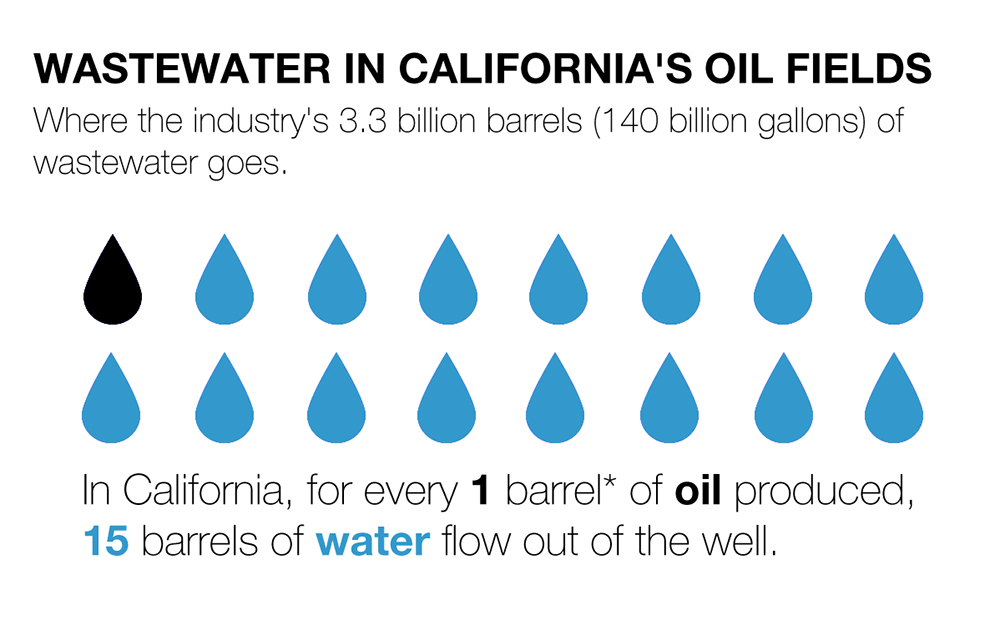
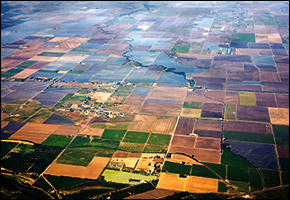
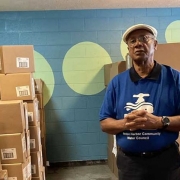
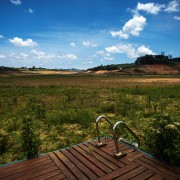
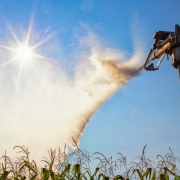


Pretty good story up until the last paragraph BS. You know the climate is not actually causing the drought. Here http://news.yahoo.com/report-global-warming-didnt-cause-big-us-drought-211545586.html That is a natural weather cycle, a wet cycle was in the mid 1980’s and a dry cycle in 1970’s just like today’s which may end since a medium strong El Nino seems to be developing.
here is the actual rise in the ocean http://tidesandcurrents.noaa.gov/sltrends/sltrends_global_station.htm?stnid=750-012
2.28 inches in 100 years.
per here the climate is not even changing http://canadianawareness.org/2013/02/ipcc-head-rajendra-pachauri-acknowledges-17-year-stall-in-global-warming/
The world may be cooling if greenland is representative as it has gained back ice here http://www.arctic.noaa.gov/reportcard/greenland_ice_sheet.html and of course antarctic sea ice is at record highs.
here is the official fudge temperature versus the satellite data http://euanmearns.com/the-diverging-surface-thermometer-and-satellite-temperature-records-again/
[Here is the fudge versus real for your town http://berkeleyearth.org/data/
Here is the rubuttal to Obama claims http://www.scribd.com/doc/224538945/NCA-Rebuttal
This article contains an error, a misstatement. It states San Benito County does not receive imported water from the State Water Project. Water in San Benito County is managed by San Benito Couty Water District in Hollister which while not an SWP contractor does have both ag service and urban contracts with the Central Valley Project and gets thaat water from San Luis Reservoir via the San Felipe Conduit. You might also note that Pajarro Vslley water agency tried in the late 90s to secure water contracts and transferable water from the CVP and CVP contractors, However those efforts failed – there simply was not and is not enough CVP export water to go around.
This is nothing new. The over pumping from the Coastal Aquifers has made it a problem for decades.
While the cause of the saline intrusion into these important basins from overdrafting of the groundwater basins is clear: growers’ decades-long practice of intensive agriculture dependent on ever increasing water supplies from groundwater; the “solution” proffered by the import of treated wastewater (industrial, agricultural and municipal) is, however, very problematic, and is not covered or addressed in this report.
Treated wastewater, even ‘tertiary’ levels of treatment by conventional wwtps, leaves significant contaminants in the water: chlorination byproducts, endocrine disruptors, pesticides, herbicides, fungicides, some heavy metals, viral particles, and other chemical and biological pollutants that are know to cause cancer, hermaphrodism in amphibians, altered sexual maturity and dysfunctions, and other serious problems for fish, wildlife and humans. Combination byproducts, resulting from the interactions between contaminants in treatment storage and pipes, add another dimension of troubling chemistry to the recycled soup.
While many of these contaminants are listed as ’emerging toxics’ by EPA and CalEPA and the medical community, they are not subject to regulation under federal and state law (thanks to intensive lobbying by the chemical, municipal water treatment and agricultural industries). As a result, wwtp operators can claim to operate ‘meeting state and federal clean water standards.’
Cumulative impacts of the residual chemistry of regular and continual use of ‘treated’ or ‘recycled’ wastewater will likely be severe over not that many years. The use of this water for growing food crops is really a threat to people’s health and sustainable agriculture in the region, potentially causing significant damages to soil chemistry and organisms, as well as to cultivated crops that depend on the health of the soil and water media they grow in.
Failure to address these problems might well be the death knell for successful agriculture in this region.